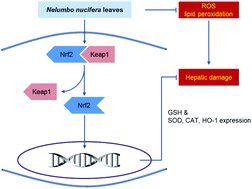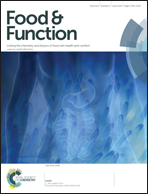Nelumbo nucifera leaves protect hydrogen peroxide-induced hepatic damage via antioxidant enzymes and HO-1/Nrf2 activation
Abstract
Naturally occurring phenolic compounds are widely found in plants. Here, the phenolic composition and hepatoprotective effect of the butanolic extract (BE) from Nelumbo nucifera leaves against H2O2-induced hepatic damage in cultured hepatocytes were investigated. BE showed high total phenol and flavonoid contents, and major phenolic compounds are quercetin, catechin, ferulic acid, rutin, and protocatechuic acid by HPLC analysis. BE effectively scavenged 2,2-diphenyl-1-picrylhydrazyl (DPPH) and 2,2-azino-bis(3-ethylbenzthiazoline)-6-sulfonic acid (ABTS) cation radicals (IC50 values of 5.21 μg mL−1 for DPPH and 6.22 μg mL−1 for ABTS+) and showed strong reducing power. Pretreatment of BE prior to 650 μM H2O2 exposure markedly increased cell viability and suppressed H2O2-induced intracellular reactive oxygen species generation and AAPH-induced cell membrane lipid peroxidation. In addition, BE up-regulated intracellular glutathione levels under normal and oxidative stress conditions. Notably, the hepatoprotective effect of BE was directly correlated with the increased expression of superoxide dismutase-1 (SOD-1) by 0.62-fold, catalase (CAT) by 0.42-fold, and heme oxygenase-1 (HO-1) by 2.4-fold. Pretreatment of BE also increased the nuclear accumulation of Nrf2 by 8.1-fold indicating that increased SOD-1, CAT, and HO-1 expressions are Nrf2-mediated.



 Please wait while we load your content...
Please wait while we load your content...